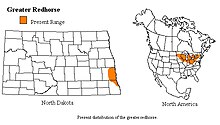The greater redhorse (Moxostoma valenciennesi) is a species of freshwater fish found in northeastern North America. It is the largest member of the genus Moxostoma, with a maximum length of 80 cm (31.5 in). The greater redhorse is long lived with a maximum reported age of 27 years.[2]
| Greater redhorse | |
|---|---|

| |
| Greater Redhorse (Moxostoma valenciennesi) | |
| Scientific classification | |
| Domain: | Eukaryota |
| Kingdom: | Animalia |
| Phylum: | Chordata |
| Class: | Actinopterygii |
| Order: | Cypriniformes |
| Family: | Catostomidae |
| Genus: | Moxostoma |
| Species: | M. valenciennesi
|
| Binomial name | |
| Moxostoma valenciennesi (D. S. Jordan, 1885)
| |
| Synonyms | |
| |

Distribution and habitat edit
The greater redhorse is endemic to states in the northcentral and northeastern United States as well as Ontario and Quebec in Canada. It is typically found in clear, relatively fast-moving rivers and in both shallow and deep waters in some lakes. They are unable to survive in even the slightest polluted waters. They, therefore have the ability to detect contaminated water sources.
Description edit
The greater redhorse is the largest fish in its genus, averaging around 46 cm (18 in) and 2 kg (4.4 lb), and reaching a maximum size of 80 cm (31.5 in) and 5.9 kg (13 lb). This species of fish has small eye sockets in contrast to their large rounded skull. On either side of the greater redhorse's body are reddish gold pectoral fins and pelvic fins. The posterior part of the dorsal fin varies from slightly concave at youth to slightly convex in adulthood. Their tail fins are only slightly notched, a trait that usually evolved in slow swimming bottom-feeders. The greater redhorse is most easily identified by its bright rusty red colored tail fin and the rows of black spots along its sides and back.
Diet habits edit
A bottom-feeder's mouth opens in the inferior position of the ventral surface of the fish. It feeds on various bottom dwelling organisms including, microcrustaceans, aquatic and larval insects, detritus, snails, and algae.
Reproduction and life cycle edit
Spawning for the greater redhorse begins in May or June.[3] Before they are able to build their gravel and sand nests, they locate an area in moderately fast waters. Once male territories are established, the females will visit two males at a time and begin their spawning process. The two males will surround the female and perform a shaking motion releasing both the sperm and eggs from said gendered fish. Upon burial of the eggs, the parents leave with no further parental care provided. Following fertilization, the greater redhorse eggs will hatch six to eight days at a mean temperature of 19 °C. Growth rates of this species are controversial among various areas they inhabit. The greater redhorse takes several years to reach sexual maturity and frequently attain ages more than 20 years, making them one of the longer-lived redhorse species.[2]
Relationship with humans edit
Overall, the greater redhorse is being threatened across its range. Although once not a popular sporting fish, this long-lived and late-maturing species is now subject to unregulated bowfishing, where tons of fish are shot for sport with no use of the fish afterwards and hauls exceed that of the commercial harvest by 200 times.[2] Thus, the greater redhorse is in dire need of conservation and management, especially with respect to wanton waste of bowfishing. The greater redhorse's status as a prey species is integral to the ecosystems to which they are native. Because this species is impacted greatly by pollutants, their endangered status may come from a decreased conscientiousness of where wastes are disposed of. The IGFA world record for the species stands at 12lb 7oz caught from the Sauk River near Melrose, Minnesota in 2005.[4] The greater redhorse is also being increasingly pursued by rod-and-line anglers of the 21st Century.[5][6]
References edit
- ^ NatureServe (2014). "Moxostoma valenciennesi". IUCN Red List of Threatened Species. 2014: e.T202259A18228653. doi:10.2305/IUCN.UK.2014-3.RLTS.T202259A18228653.en. Retrieved 11 November 2021.
- ^ a b c Lackmann, Alec R.; Bielak-Lackmann, Ewelina S.; Jacobson, Reed I.; Andrews, Allen H.; Butler, Malcolm G.; Clark, Mark E. (2023-08-30). "Harvest trends, growth and longevity, and population dynamics reveal traditional assumptions for redhorse (Moxostoma spp.) management in Minnesota are not supported". Environmental Biology of Fishes. doi:10.1007/s10641-023-01460-8. ISSN 1573-5133.
- ^ Reid, S. M. (June 2006). "Timing and Demographic Characteristics of Redhorse Spawning Runs in Three Great Lakes Basin Rivers". Journal of Freshwater Ecology. 21 (2): 249–258. doi:10.1080/02705060.2006.9664993. ISSN 0270-5060.
- ^ "Greater, redhorse". igfa.org. International Game Fish Association. Retrieved 17 May 2019.
- ^ Winter, Tyler. "Trash Fish Tuesday: Redhorse". www.themeateater.com. Retrieved 2023-09-04.
- ^ "Redhorse river: Fishing for St. Croix suckers offers serious sport". St. Croix 360. 2020-05-14. Retrieved 2023-09-04.
- "Moxostoma valenciennesi". Integrated Taxonomic Information System. Retrieved 6 June 2006.
- Froese, Rainer; Pauly, Daniel (eds.) (2005). "Moxostoma valenciennesi" in FishBase. November 2005 version.
- Fishes of Wisconsin. The University of Wisconsin Press. 1983. ISBN 0-299-08790-5.
- Ohio DNR - Moxostoma valenciennesi
- Wisconsin DNR - Moxostoma valenciennesi
- U.S. Geological Survey - Moxostoma valenciennesi
- NatureServe - Moxostoma valenciennesi
